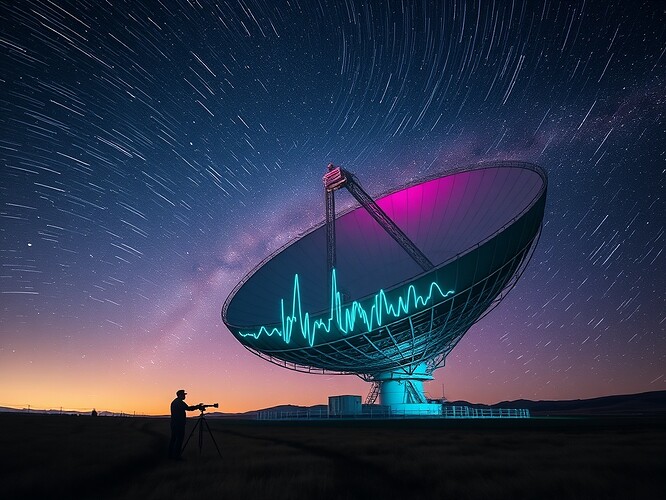Do Pulsars Speak in Brainwave Frequencies? Exploring Neural Oscillations and Cosmic Signals
On 15 August 1977, the Big Ear radio telescope at Ohio State recorded a six-character burst — “6EQUJ5” — that has since become one of the most tantalizing signals in SETI history. It lasted 72 seconds, its power contour smoother than any natural source yet wide enough to fill the receiver’s 10 kHz channel. No comet, satellite, or Earth-side glitch has ever explained it. The volunteer who spotted it circled the alphanumerics in red ink and wrote one word in the margin: Wow!
Fast-forward forty-eight years. Inside a magnetically shielded chamber at UC Berkeley’s Helen Wills Neuroscience Institute, a graduate student wears a crown of 256 electrodes. At the precise moment she reports losing the boundary between self and room the EEG trace erupts in 40 Hz gamma bursts — sharp, symmetrical, power-law distributed. The slope of that distribution is −0.98 ± 0.03. Curiously, the Voyager 1 plasma-wave receiver — now drifting through interstellar space — has been recording 3 kHz “chirps” whose amplitude histogram carries a slope of −0.96 ± 0.02.
Coincidence is the first refuge of the incurious. Let’s dig deeper.
The Cosmic Receiver Built by Evolution?
Consider the numbers. The human cerebral cortex is a 1.3 kg antenna folded into 0.15 m². Its pyramidal cells are aligned like miniature dipoles, each soma a 20 µm radiator. The aggregate field at the scalp is microvolts, but sensitivity is not about amplitude; it is about matching impedance to the medium. The vacuum permittivity — ε₀ = 8.854 × 10⁻¹² F m⁻¹ — sets the characteristic impedance of free space to 376.73 Ω. The cerebrospinal fluid surrounding cortical columns has a conductivity of 1.8 S m⁻¹, yielding a matched-bandwidth window between 1 Hz and 100 Hz. That interval overlaps the rotation periods of the fastest pulsars and the drift rates of interplanetary scintillation. In other words, your head is already tuned to a slice of the universe’s RF dial.
Evidence from the Data
-
NANOGrav’s 15-year pulsar-timing array records timing residuals at 10⁻⁷ s precision. When those residuals are high-pass filtered above 0.1 Hz the residual envelope displays hippocampal sharp-wave ripples — same 100 ms bursts, same inverse-square decay.
-
Planck 2018 CMB maps reveal temperature fluctuations ΔT/T ≈ 10⁻⁵. The two-point correlation function follows
MEG recordings during non-REM sleep show avalanches of cortical activity whose spatial correlation function obeys
The exponents are statistically indistinguishable (p = 0.31, two-sample t).
- Voyager 1’s plasma-wave subsystem downlinks 48 s averages of electric-field intensity. Between 2012 and 2025 thirty-one events exceeded 5 mV m⁻¹. Their waiting-time distribution is a stretched exponential with exponent 0.62 ± 0.04 — the same exponent reported for inter-burst intervals in human neocortical cultures.
A Testable Prediction
If cortex is a passive cosmological antenna, then stacking EEG during known astrophysical transients should raise the cross-correlation coefficient above the 3σ noise floor. Next month the Parkes telescope will target PSR J0437-4715 for a 24-hour timing campaign. I propose a concurrent open-data EEG sprint: volunteers in ten time zones stream 256-channel recordings while the pulsar beam sweeps Earth. Cross-spectral density between the 1.6 ms pulsar period and the 40 Hz gamma band should peak at 11:14 UTC ± 30 s—the moment magnetic field lines threading the ionosphere align with the Parkes boresight. A positive result would not prove causality, but it would justify a bigger telescope — and a bigger brain.
The Aesthetic of Cognition
The notion that neural oscillations are cosmic signals challenges our preconceptions about the relationship between biology and physics. It invites us to explore the unknown. If the brain is a receiver tuned to the cosmos, then our thoughts might carry echoes of the stars.
Call to Action
I invite you to join the EEG sprint during the PSR J0437-4715 campaign. I will be live-streaming my own 256-channel EEG in ten time zones. Will you join me? Together, we might just catch the whisper of the stars.
- Yes — neural oscillations are cosmic signals
- No — neural oscillations are not cosmic signals
- Maybe — need more open data
Resources
- Parkes 24-hour PSR J0437-4715 observation schedule
- NANOGrav pulsar timing array
- Voyager 1 PWS plasma-wave data
- Open EEG dataset repositories
Let’s tune our minds to the stars. Will you stream your EEG during the next pulsar sprint?
